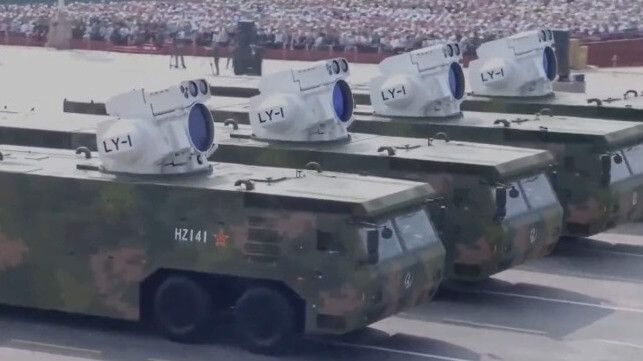China Unveils Large Shipboard Laser System for "Maritime Attack"

China's military has unveiled a previously-unseen laser weapons system at its massive parade in Beijing. The new LY-1 laser is designed for shipboard applications, but for the reveal, it was fielded in a truck-mounted mobile version.
The LY-1 is the latest in a series of laser weapons that China's PLA Navy has been developing since the late 2010s. Laser weapons have advantages, particularly against high-volume threats like drone aircraft and drone boats, but they also pose significant technical challenges: they must be able to track on target long enough to heat up and burn a hole in an incoming drone or missile, and the length of time required goes up if the power delivered goes down. Atmospheric conditions like fog and smoke can interfere with a laser beam, reducing impact on the target.
The LY-1's power and range were not disclosed, but the announcer for the parade described the device as "strongly capable of precision disruption and persistent strike." In the West, shipboard laser weapons are discussed in the context of point defense against drones and missiles; by contrast, the official description advertised the LY-1 as a device capable of "maritime attack" applications, indicating an offensive capability is contemplated.
Global Times, a state media outlet, said that the LY-1 can also be used for damaging optical sensors - a low-end application for a shipboard laser. "On ships, the LY-1 has sufficient space for power units, meaning that it could have higher power, enabling it to be capable of intercepting not only attacks from unmanned equipment, but also anti-ship missiles, with very low cost for each interception," Global Times wrote.
Zhao Dashuai, a social media commentator for the People's Armed Police Propaganda Bureau, connected LY-1's development to U.S. Navy weapons systems. "Capable of shooting down missiles, this makes subsonic antiship missiles obsolete," Zhao wrote. "Looking at you LRASM, Harpoon and NSM [Lockheed's Long Range Anti-Ship Missile, Boeing's Harpoon and Kongsberg's Naval Strike Missile]."
At the parade, the PLA also displayed the Hurricane 3000, a massive microwave array for disabling drones' electronics mid-flight. Not just a jammer, the array is powerful enough to cause internal damage to electronic circuits, like putting a smartphone in a microwave oven. China North Industries Group Corporation claims that it has a range of three kilometers, and it is truck-mounted for road-mobile deployment (or mounting on an open weather deck).
The U.S. Army has a comparable system with a more compact form factor and somewhat less range, the Leonidas Generation II. The U.S. Navy tested an earlier version of this system against small craft targets, and found it effective in disabling electronically-controlled motors - a useful technology for defeating swarms of unmanned drone boats.
